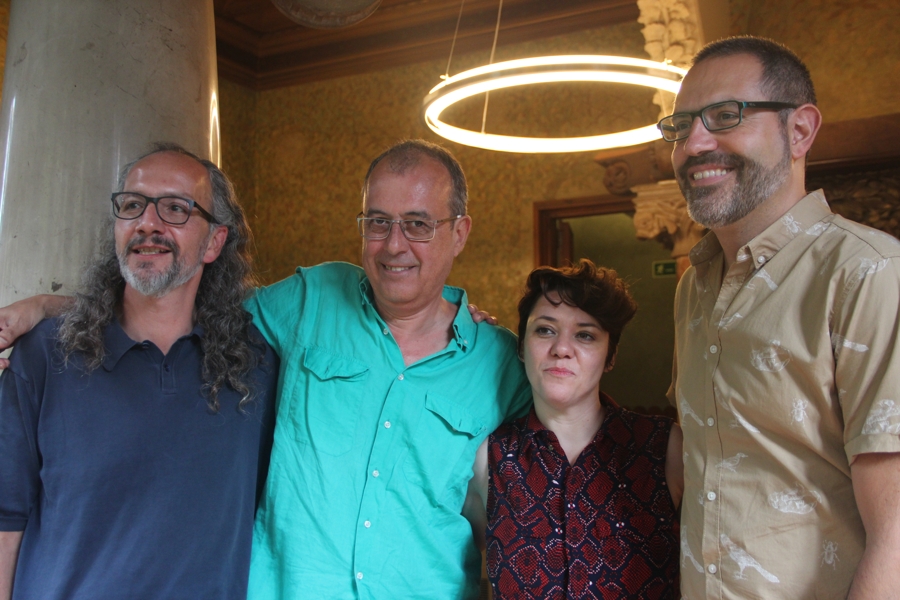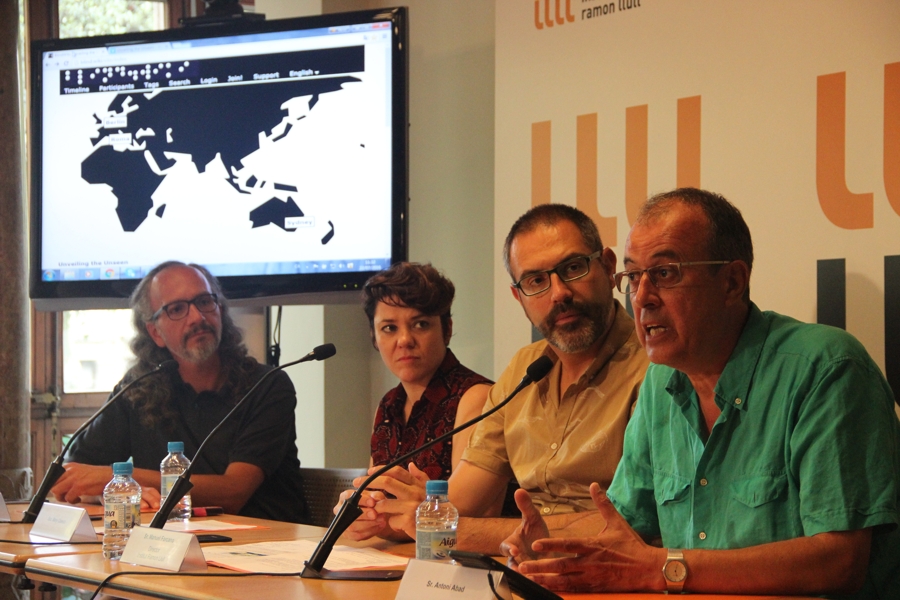The Catalan nomination at the Art Exhibition of the Venice Biennale, by the artist Antoni Abad, will be curated by Mery Cuesta and Roc Parés
Antoni Abad proposes an interpretation in sensorial code of the urban space that is Venice. The artist will create the project, ‘La città che non si vede’ in collaboration with a local group of blind and visually impaired people. This collective uses their senses in a different way than the majority of the population, who rely on full vision, and for whom the majority of urban spaces and IT app interfaces are designed. Internationally recognized for his work with digital communities, Abad, with the aid of this collective, reveals a different Venice; one that is not seen but heard, felt and experimented with. This is a Venice that breaks from the stereotypical vision of gondolas, bridges and palaces. Thus, the Catalan contribution to the 57th Art Exhibition of the Venice Biennale offers up a paradoxical space: an exhibition dedicated to the senses - and more specifically, to all that cannot be seen - at a Biennale of visual arts.
In Venice Antoni Abad will introduce the BlindWiki project, a network open to public participation that uses mobile phones as a social communication geolocating device. BlindWiki (www.blind.wiki) has been developed on an international level thanks to first-person experiences from blind citizens in other cities, such as Rome, Sydney or the Berlin Biennale of Contemporary Art. It will land in Venice in an advanced and efficient version, adapted specifically to the Venice Biennale.
Mery Cuesta and Roc Parés' proposal combines the uniqueness of the BlindWiki project with the need for interaction and contemplation of a pavilion within the framework of the Venice Biennale. The Catalan exhibition will present a space of cultural experimentation and research that is open to social participation, with the material created being supplied to the BlindWiki project by Antoni Abad.
Abad's project for the Catalan nomination in Venice will be simultaneously developed inside and outside of the pavilion. The artist's work with the collectives of visually impaired people has them uploading and making public their everyday movements and experiences on the project’s network and webpage. This mapping work is made accessible to the Biennale public and to the citizens in general through a series of boat tours in the canals of Venice, amongst other ways. In these daily itineraries that any citizen or visitor of Venice would normally follow, the use of the BlindWiki app designed by Antoni Abad will allow you to listen to the commentaries, sounds and recordings that this collective of blind and visually impaired people are mapping out around the city. The canals follow a narrative thread of the impressions of a group using a mobile device as a means of expression and personal communication. In this way the connecting element chosen to link these maps and times are the canals, tools of Venetian urban planning that completely condition the lives of its population. In summary, the Catalan pavilion will be the nerve center of an inclusive sensorial tour of the city's canals. In addition, the curators' proposal for the Biennale also includes an international symposium about geolocating and data sensorization, as well as a graphic novel in braille, an entirely pioneer idea.
The map of Venice that you cannot see will begin to be created before the Biennale's inauguration, thanks to the meetings that the artist Antoni Abad will have with associations of blind people along with high school and university students. Over the course of the Biennale, the mobile app and the BlindWiki webpage will be fed by the contributions made by the citizens.
Roc Parés Burguès (Mèxic, D.F., 1968). Interactive communications research artist. Parés holds a PhD in Audiovisual Communications (UPF, 2001) and an undergraduate degree in Fine Arts (UB, 1992). He is an Associate Professor and Researcher in the DigiDoc Group of the Communications Department at the Pompeu Fabra University. His artistic work is characterized by poetic and critical experimentation of digital technologies, and it has been presented and exhibited internationally at the Center for Contemporary Culture in Barcelona, the Joan Mirò Foundation, the Reina Sofia National Museum of Art, the Cultural Center of Belem, the Tate Gallery, the Art Gallery of Ontario, the National Museum of Photography, Film and Television, the Spanish Cultural Center of Mexico, Ex Teresa Arte Actual, Laboratoire Paragraphe Université PARIS 8, Brandts Danmarks Mediemuseum, and the Centrale Montemartini, amongst others. His research projects have been published in the British Computer Society, the Academic Press, FECYT, Macba, and MIT Press, amongst others. He has collaborated with dozens of artists, scientists, engineers, institutions and collectives with whom he has launched pioneer platforms in electronic art, such as, for example, the Virtual Gallery (Museum of Science 1993-1995 and UPF 1995-2000) dedicated to the development of virtual reality as an art form; 'Macba En Línea' (Macba+UPF 1995-1997) dedicated to on-line art; M.A.L. (HANGAR+MOB European Commission 2011-2013) dedicated to art with smart-phones; and the Digital Arts University Masters, UPF (1995-2015), of which he was co-director from 2010 – 2015.
Mery Cuesta (Bilbao, 1975) is an art critic, exhibition curator, teacher and illustrator. As an art critic she can regularly be found in the Cultura/s section of La Vanguardia newspaper, where she publishes a weekly art opinion piece entitled, “Centellas”, since 2002. She also writes articles and essays for many other publications. In 2002 she won the Espais Award for Art Criticism thanks to which she published her first book, an analysis of Spanish experimental cinematographic production in the ‘70’s. With the Consonni publishing house Cuesta just published “La Rue del Percebe de la cultura y la niebla de la cultura digital”, an essay on the effects of digital culture on consumer culture.
As a curator Cuesta’s projects address questions relative to the analysis of consumer culture, pop culture and the critical dissection of the working mechanisms of contemporary art. The following exhibitions are worth mentioning: ‘Videoclisión’ (Centro Galego de Arte Contemporánea), ‘Low Cost’ (Foment de les Arts Decoratives FAD), ‘Quinquis de los 80: Cine, prensa y calle’ (CCCB, La Casa Encendida, Centro de Historia de Zaragoza i Alhóndiga de Bilbao), ‘La mano izquierda de Cervantes’ (Instituto Cervantes – Karsi Sanat, Estambul), o ‘Humor absurdo: Una actitud ante la vida en situaciones críticas’ (Artium). Since 2013 she has worked as a Brand Curator for various international brands. Her upcoming project as a curator will address artistic creations in jails and will be presented in the fall of 2016 at CaixaForum Barcelona.
As a teacher Cuesta is the Director of the Masters program in Illustration and Comics at Elisava – the Barcelona School of Engineering and Design. She has also given classes, workshops and presentations on curating, art criticism, pop culture and exhibition design in various universities and centers (Ramon Llull Institute, the Spanish Cultural Center in Mexico, the Center for Design, Cinema and TV of Mexico).
Mery Cuesta’s work as a theorist, teacher and author in the world of illustration and comics centers around the fusion of comic language and cultural criticism. As an illustrator she has published various essay-style and culturally critical series and comic strips for magazines, such as Barcelonés, TMEO, La Cruda, Resitencia (Mex) and Mongolia. Her illustrations have been exhibited in various galleries and she has published three albums.
Antoni Abad (Lleida, 1956) has a degree in Art History from the University of Barcelona (1979) and a European Media Masters from the University of Pompeu Fabra (1997). In 2006 he received the National Award for Visual Arts from the Generalitat de Catalunya and the Golden Nica Digital Communities from Prix Ars Electronica in Linz, Austria.
Abad has participated in the Biennales in Venice and Lima (1999), Sevilla (2004 and 2008), Mercosul Porto Alegre (2009) and Berlin (2016). His projects have been presented at the Centro de Arte Reina Sofía, La Casa Encendida i Matadero in Madrid; MACBA and Centre d’Art Santa Mònica in Barcelona; the New Museum and P.S.1. in New York City; Hamburger Banhof in Berlín and ZKM de Karlsruhe in Germany; Musac in Leon, Centre d’Art Contemporain in Geneva, Museo de Arte Moderno in Buenos Aires; Laboratorio de Arte Alameda and Centro Cultural de España in Mexico, and the Centro Cultural Sao Paulo and Pinacoteca do Estado de Sao Paulo in Brazil, amongst others.
Between 2004 and 2014 Abad has focused his attention on the creation of audiovisual communication projects for the Internet using mobile phones with marginalized groups in Mexico City, Lleida, Leon, Madrid, Barcelona, San José (Costa Rica), Sao Paolo, Geneva, Manizales (Colombia), the Algerian Sahara, New York City, and Montreal (Quebec, Canada). Taxi drivers, immigrants, refugees, disarmed guerilla fighters, and handicapped people have actively participated in his projects, publishing their daily routines and experiences on the webpage: www.megafone.net.
In the fall of 2014 at the Spain Academy of Rome the development of the BlindWiki project began, a prototype of an Internet network conceived by blind and visually impaired people. The participants use their mobile phones to create audio recordings of their daily experiences in their city that are immediately published through geolocating. Using the BlindWiki app, other previously published recordings are always accessible on mobile devices, reflecting the urban landscape as it is being experienced by people with diverse levels of vision. The project promotes the collaborative creation of a public sensorial map that can be extended to other cities and that can be used by both the collective of people by whom it was made as well as the general public. Along with the Rome project, BlindWiki has also been started in Sydney (2015) and at the 9th Berlin Biennale in June 2016. The participants’ contributions are accessible via the mobile app in the streets of the aforementioned cities as well as on the project’s web page.
The proposal was chosen by an independent jury led by Xavier Antich along with Martí Manen, Chus Martínez, Martí Peran, Nekane Aramburu, Antoni Muntadas i Ferran Barenblit and Marta Oliveres, the director of the Creation Department at the Ramon Llull Institute, who participated as the spokesperson without voting privileges.
This will be the fifth time that the Ramon Llull Institute presents Catalonia at the Venice Biennale, which will take place from May 13th – November 26th, 2017 and which will be headed by Christine Macel as the Artistic Director. In the previous edition Ramon Llull presented the project, “Singularity”, by the filmmaker Albert Serra and curated by Chus Martinez.
x02z17
The jury has chosen the project, ‘La città che non si vede’, by the artist Antoni Abad and curated by Mery Cuesta and Roc Parés
Premsa
Premsa italiana i Internacional:
- Alessandra Santerini, e-mail: alessandrasanterini@gmail.com, cell. +39 335 6853 767
- Giovanni Sgrignuoli, e-mail: giovanni.sgrignuoli@gmail.com, cell. +39 328 9686390
- Giordana Zagami, e-mail: giordanazagami@gmail.com , cell +39 338 5854237
Premsa catalana i espanyola:
- Miriam Giordano, e-mail: miriam@laboh.net, cell. +34 606 602 230


